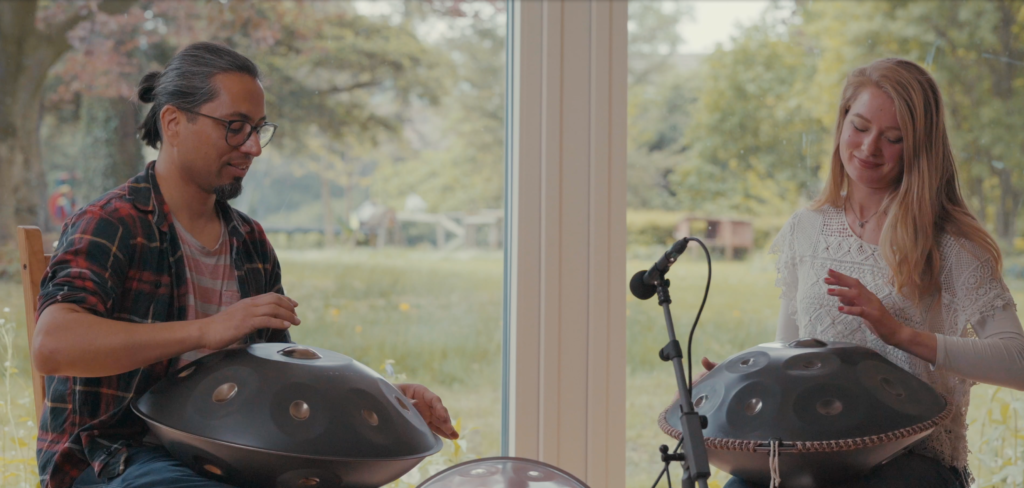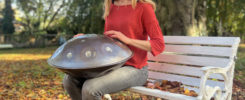First Exercises and Care
The choice of handpan has been made, and now the adventure truly begins. But the first challenges are already waiting to be mastered: How should I store my handpan? How often should I play? What is the proper care? And what are some good first exercises for beginners?
In this second part of the Beginner’s Guide, we’ll explore these topics together. Alongside Rafael Sotomayor, the maker of the Opsilon Handpan, we aim to support you in learning and discovering the handpan. We’ll start by focusing on practicing and the importance of regularity, then we’ll take a closer look at storage and care, and finally, we’ll address some general questions.
On Practicing and Regularity:
What are some good beginner exercises that I can do without any experience?
Rafael: We recommend every beginner attend our workshop. It’s particularly important in the beginning that both the right and left hands perform the same movements. Specifically, the movements of the right and left hand should be identical. It’s also important that we use at least four fingers to play—both thumbs as well as the index or middle finger, with additional fingers being incorporated later. It’s essential to practice with multiple fingers so that you have more options available in the future. For example, this allows you to play multiple notes simultaneously, enabling you to play chords or arpeggios.
At the start, it’s best to learn the technique correctly from the ground up. Correcting mistakes is much more complicated than learning it correctly from the beginning.
There are a few simple and initial exercises, such as playing the scale of the instrument. We start by playing the lowest note with the right hand and alternate hands up to the highest note. The highest note is located far from your body, while the lowest is closer. On the Opsilon handpan, the highest note is located beneath the “Opsilon” inscription. This creates a logical sequence as you literally ascend the scale. With the note in the center of the instrument (the “Ding”), you can practice rhythm, playing it like a drum. You can explore intuitively in all directions while maintaining the tempo of the beat. However, to get started correctly, an (online) workshop is optimal.
Tip: If you’re still unsure, you should check out the workshop trailer on YouTube: https://www.youtube.com/watch?v=C6LAfN3Mwbc
How often should I practice each day or week?
Rafael: We recommend practicing every day! A minimum of 10-20 minutes is enough. Playing the instrument can be a small break from reality—a form of meditation or music therapy that is beneficial, giving you time for yourself and your handpan. That’s why it’s so important to play every day and not just once a week. You will notice the difference, and experience shows that development is much faster. However, there are no limits to how much you can practice. It’s also about consciously deciding to play the handpan every day.
In this way, you also learn self-discipline—but to sum it up: 10-20 minutes every day is better than playing for several hours once a week.
Should I warm up my fingers before playing?
Rafael: We always start by playing slowly and gradually increasing the tempo. As a result, no special warm-up exercises are needed since we use playing to warm up. Conscious and deliberate strikes are the first exercises, and the correct arm movements also prepare us mentally before we slowly increase the tempo.
In other words, specific warm-up exercises before playing are not so important.
What are some good beginner songs for first exercises?
Rafael: In general, songs are great for getting inspiration and possibly learning from other musicians. Especially in D Minor, there are countless videos online to get ideas or try to mimic the movements of musicians and understand how to build or play a song. Good beginner songs ideally have simple melodies and a bass alternation with the right and left hands. However, I believe it’s better to play intuitively and compose your own songs. Start by playing a harmony and then try to develop it.
Tip: Use the “question and answer” game to start composing independently.
Rafael: The right side asks a question, and the left side plays an answer. Both sides play the same number of notes alternately. This is also a great exercise for learning how to build melodic elements, which can then be used in a composition. Since the handpan is still a relatively new instrument, there aren’t many classic handpan songs to play yet.
Which instruments harmonize particularly well with the handpan?
Rafael: Personally, I find that the best instrument combinations are those that don’t have similar frequencies. For example, low instruments like bass, cello, or double bass. Percussion instruments are also great because you have a rhythmic partner and can play melodically yourself. But keyboards with deep pads also work well as partners. In principle, you can combine any instrument with the handpan, but the sound should be clean, and each instrument should be audible in the end. Guitar and harp have similar frequencies but can harmonize very well. Ultimately, it’s a matter of taste, and everyone should choose the combination that resonates with them—if they even want to combine instruments at all.
How long does it take to compose your song?
Rafael: That’s a difficult question. Some people compose a song immediately, while others may never manage to compose their own song. It might be a matter of talent or simply a mental block. Perhaps one doesn’t believe they’re capable, or they think that their compositions won’t appeal to anyone. But primarily, the song you compose should appeal to one person above all: yourself.
Here, we can revisit the “question and answer” game. For example, play three notes on the left side and ask a question, then answer with three notes on the right side, played with both hands, and then vary it upwards or downwards. This way, you explore different corners of the instrument and try to play different notes with both hands simultaneously. Intuitive harmonies can emerge this way. What you like, you keep, and then build on it further, gradually developing it into a song.

Care and protection:
How often should I clean my Opsilon?
Rafael: First of all, you should clean the instrument with a microfiber cloth after each playing session. This is a dry cleaning, meaning you don’t need TurtleCare, oil, or anything similar. This is important because while playing, we sweat, and moisture, salts, and acids can accumulate on the instrument. As an additional layer of protection, we recommend using TurtleCare based on our experience. TurtleCare is not an oil, but a ceramic coating that should be applied once every two to four weeks, depending on how often the instrument is played.
Why do you recommend TurtleCare?
Rafael: The material of the instrument absorbs moisture, and thus also oil. If you maintain the instrument with oil, it doesn’t stay on the surface but is absorbed. This leaves the surface, which we want to protect, exposed. TurtleCare is different; the ceramic coating stays on the surface like a second skin. The hardness of the ceramic ensures that the sound remains consistent.
How should I store my Opsilon?
Rafael: For one or two days, you can leave the instrument in the hard case, as long as it’s not damp inside, because moisture can lead to rust. Moisture absorbers can help if necessary. However, we do not recommend long-term storage in the hard case. The best options are stands, wall mounts, or shelves. In our experience, wall mounts are the safest, as they are less prone to accidents. With a stand, you have to be careful, as they can sometimes be unstable, and there is a risk of bumping into it and causing it to fall over with the instrument.
What should I do if my handpan rusts?
Rafael: Rust can appear if you’re not careful, such as in a humid environment or if the instrument is left in the hard case for too long. Rust must be removed, whether mechanically or with the use of chemicals. My experience has shown that polishing is the best option, though it may affect the instrument’s color and part of the nitriding. It’s a difficult decision, but it’s best to remove the rust completely. This requires gentle sanding and polishing of the entire instrument, not just one spot, to avoid color differences.
Tip: Schedule your TurtleCare cleaning in your calendar so you don’t forget it.
How do I know if my handpan is out of tune?
Rafael: An instrument is significantly out of tune when it no longer sounds good when played. It’s not easy to determine with regular tuning devices if the instrument is out of tune, as they also measure other frequencies, including the overtones. The best way is to listen carefully—if the tone is far off from what it should be, it’s out of tune. Tuning should be done by the original manufacturer, as each knows best how their handpan is built and how it should sound. We use special tuning devices that show different tones like the fifth, octave, and root note. If the instrument is out of tune, it will show not only a changed root note but also out-of-tune overtones. If you’re unhappy with the sound, you should send it back to the manufacturer for repair.
Opsilon handpans come with a five-year tuning guarantee because our instruments are strong and stable.
Can I repair or tune my handpan myself?
Rafael: We strongly advise against tuning or repairing the instrument yourself. This requires years of experience, as it’s not just one out-of-tune note but also out-of-tune overtones. Since the notes are interconnected, a hammer strike affects other notes, meaning we tune multiple notes at the same time. The manufacturer knows where to strike to adjust the tones in the right direction.
Tip: We strongly advise against buying cheap handpans from China, as they are often out of tune from the start, and repairs can be difficult and expensive.
I want to play my handpan outdoors. What should I be aware of?
Rafael: First of all, you should not play directly under the sun, as this will warm the instrument and affect the sound, making it dull and causing the overtones to be lost. If the instrument is well-built, there will be no permanent detuning; the sound change is only temporary, as the structure doesn’t change below about 180 degrees. However, to avoid this, the instrument should be played in the shade or in a cool place to ensure the overtones fully resonate. Additionally, if exposed to direct sunlight for too long, the instrument can become so hot that it can burn you. Another concern is moisture or wetness. Before transporting the instrument, it should be dried with a hard case to prevent moisture from getting trapped inside the fabric.
We hope this post has been helpful and has supported you in your first steps on your journey into the world of handpans. Next, we’ll explore the topic of “Traveling with a Handpan.” If you have any suggestions or questions, feel free to leave us a comment—we’d love to hear from you. Until next time, your Opsilon Team!
You can find practical first exercises for at-home practice in our online store:
Online Tutorial




